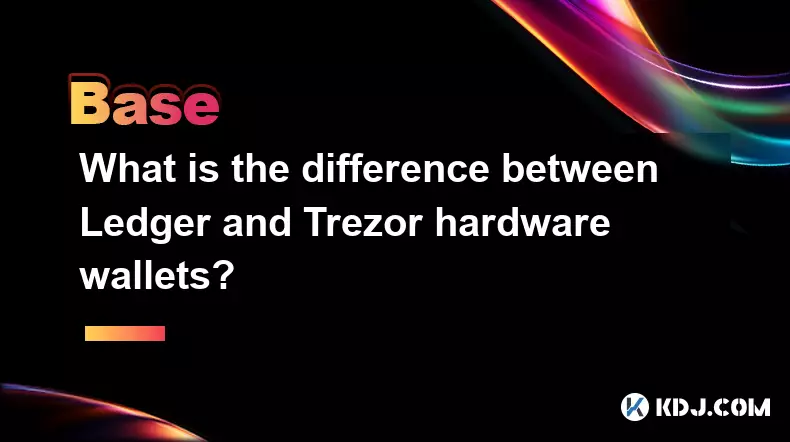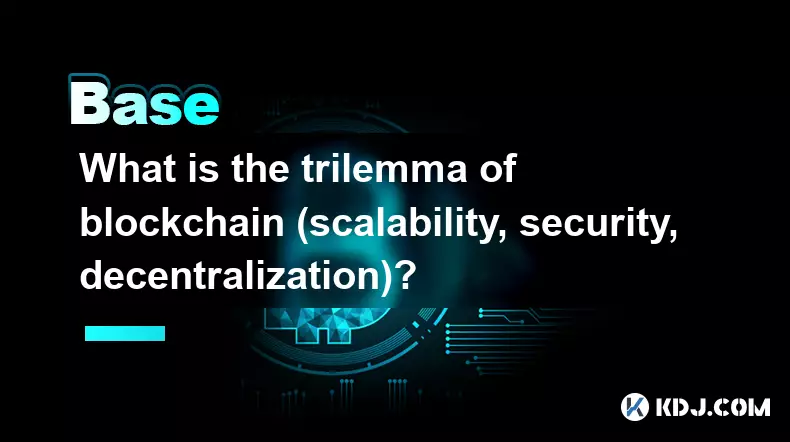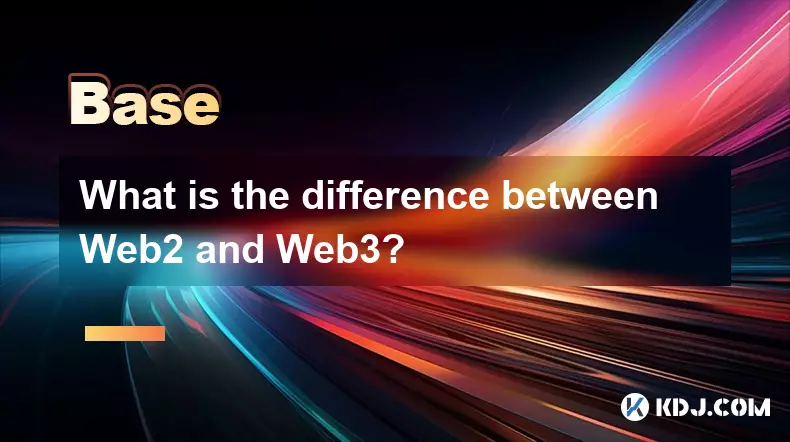-
 bitcoin
bitcoin $110047.851143 USD
-1.37% -
 ethereum
ethereum $3727.617466 USD
-1.30% -
 tether
tether $1.000961 USD
-0.05% -
 bnb
bnb $1114.045467 USD
1.72% -
 xrp
xrp $2.343280 USD
0.14% -
 solana
solana $174.674876 USD
-5.85% -
 usd-coin
usd-coin $0.999999 USD
0.02% -
 tron
tron $0.311757 USD
-2.44% -
 dogecoin
dogecoin $0.183678 USD
-3.76% -
 cardano
cardano $0.627109 USD
-2.07% -
 ethena-usde
ethena-usde $1.000300 USD
0.15% -
 hyperliquid
hyperliquid $36.865760 USD
-2.74% -
 chainlink
chainlink $16.968918 USD
-1.48% -
 stellar
stellar $0.318159 USD
0.47% -
 bitcoin-cash
bitcoin-cash $500.637224 USD
-1.56%
What is the difference between Ledger and Trezor hardware wallets?
Trezor emphasizes open-source transparency and on-device verification, while Ledger leverages secure hardware chips for enhanced physical protection.
Oct 11, 2025 at 08:19 am

Differences in Security Architecture
1. Ledger utilizes a Secure Element chip, a feature commonly found in banking cards and smartphones, to store private keys. This hardware-based protection isolates sensitive data from potential malware threats during transactions.
2. Trezor relies on open-source firmware and a microcontroller without a Secure Element, which means its security model depends heavily on software-level encryption and user practices such as strong PINs and passphrase protection.
3. Ledger’s use of certified chips provides an added layer of resistance against physical tampering, making it harder for attackers to extract keys even if the device is compromised physically.
4. Trezor counters this by offering transparent development processes, allowing public audits of its codebase, which fosters trust through community scrutiny rather than proprietary hardware components.
User Interface and Experience
1. Ledger devices typically require interaction through companion applications like Ledger Live, which runs on desktop or mobile platforms. This adds functionality but also introduces a dependency on external software.
2. Trezor integrates more functions directly into the device interface, enabling users to confirm transactions and manage accounts using buttons and a built-in screen with minimal reliance on host devices.
3. Trezor's approach reduces exposure to compromised computers since transaction details are verified independently on the device itself, minimizing risks associated with malicious software on connected machines.
4. Ledger has improved its verification process by displaying addresses and amounts on-device, yet still requires users to navigate settings and setup primarily through external apps.
Supported Cryptocurrencies and Ecosystem Integration
1. Both wallets support a wide array of cryptocurrencies, including Bitcoin, Ethereum, and numerous ERC-20 tokens, but their update mechanisms differ significantly.
2. Ledger maintains tighter control over app installations via Ledger Manager, requiring users to install supported applications individually through the Ledger Live platform.
3. Trezor allows broader access through integration with third-party wallets like Electrum and MetaMask, giving advanced users greater flexibility in managing diverse digital assets.
4. Trezor’s open integration model supports decentralized applications more seamlessly, appealing to users who prioritize interoperability across blockchain ecosystems.
5. Ledger occasionally delays support for newer tokens due to rigorous internal testing, prioritizing stability over rapid deployment.
Recovery and Backup Mechanisms
1. Both devices use a 24-word recovery seed for backup, ensuring that funds can be restored on compatible wallets even if the original device is lost or damaged.
2. Ledger introduced Shamir Backup on select models, allowing users to split their seed into multiple shares with customizable thresholds for reconstruction.
3. Trezor continues to use traditional BIP39 mnemonic phrases across all models, maintaining consistency while avoiding complexity for average users.
4. Shamir Backup enhances resilience against theft or loss of a single backup medium, though it requires careful management of multiple physical locations.
Firmware Updates and Trust Model
1. Ledger signs firmware updates cryptographically, ensuring authenticity, but the signing process is controlled internally, limiting full transparency.
2. Trezor publishes all firmware updates as open-source, enabling independent verification before installation, reinforcing its commitment to decentralization principles.
3. Users concerned about centralized control may prefer Trezor’s verifiable builds, where every line of code can be audited prior to flashing.
4. Ledger provides a secure update channel through its application suite, reducing the risk of installing counterfeit firmware despite less openness in development.
Frequently Asked Questions
Can I use the same recovery seed for both Ledger and Trezor?Yes, both follow the BIP39 standard, so a seed generated on one can restore funds on the other, provided the coin and derivation path are supported.
Which wallet offers better protection against phishing attacks?Trezor displays full transaction details on-device, making it easier to detect forged destinations. Ledger also shows critical data but relies more on app integrity for initial display.
Do these wallets require internet connectivity?Neither device connects directly to the internet. They operate offline, communicating only with trusted interfaces via USB or Bluetooth when initiating transactions.
Is there a significant price difference between Ledger and Trezor models?Current flagship models—Ledger Nano X and Trezor Model T—are similarly priced, though Trezor often includes additional features like touchscreen input at comparable cost points.
Disclaimer:info@kdj.com
The information provided is not trading advice. kdj.com does not assume any responsibility for any investments made based on the information provided in this article. Cryptocurrencies are highly volatile and it is highly recommended that you invest with caution after thorough research!
If you believe that the content used on this website infringes your copyright, please contact us immediately (info@kdj.com) and we will delete it promptly.
- XRP Price Prediction: Weekend Rollercoaster or Rally?
- 2025-10-12 08:45:16
- Bittensor (TAO): Super Bullish Signals Point to Potential 2x Rally
- 2025-10-11 10:25:12
- Silver Price Correction: Navigating the Dip & Identifying Key SEO Keywords
- 2025-10-11 10:25:12
- Decoding Crypto Trends: Bittensor's Bull Run, Cardano's Dip, and LivLive's Presale Buzz in 'Uptober 2025'
- 2025-10-12 08:45:16
- MoonBull: The Crypto Meme Coin Promising 1000x Gains?
- 2025-10-11 10:30:01
- Crypto Payroll Revolution: Stablecoins, Altcoins, and the Future of Salary Payments
- 2025-10-11 10:30:01
Related knowledge

What does it mean for code to be "open source" in crypto?
Oct 12,2025 at 01:54pm
Understanding Open Source in the Cryptocurrency Ecosystem1. In the context of cryptocurrency, open source refers to software whose code is publicly ac...

What is the purpose of a "testnet"?
Oct 12,2025 at 09:01am
Understanding the Role of Testnets in Blockchain Development1. A testnet serves as a parallel version of a blockchain network, designed specifically f...

What is the difference between single-collateral and multi-collateral Dai?
Oct 12,2025 at 05:18pm
Understanding Single-Collateral Dai1. Single-Collateral Dai (SCD) was the original version of the Dai stablecoin launched by MakerDAO in 2017. It allo...

What is "EIP-1559" and how did it change Ethereum?
Oct 12,2025 at 03:00am
Understanding EIP-1559 and Its Core Mechanism1. EIP-1559 is a protocol upgrade introduced to the Ethereum blockchain as part of the London hard fork i...

What is the trilemma of blockchain (scalability, security, decentralization)?
Oct 11,2025 at 10:36am
Understanding the Blockchain TrilemmaThe blockchain trilemma is a concept that highlights the inherent challenge in simultaneously achieving three cor...

What is the difference between Web2 and Web3?
Oct 11,2025 at 03:19pm
Understanding the Structural Shift from Web2 to Web31. Web2 is characterized by centralized platforms where large corporations control user data, cont...

What does it mean for code to be "open source" in crypto?
Oct 12,2025 at 01:54pm
Understanding Open Source in the Cryptocurrency Ecosystem1. In the context of cryptocurrency, open source refers to software whose code is publicly ac...

What is the purpose of a "testnet"?
Oct 12,2025 at 09:01am
Understanding the Role of Testnets in Blockchain Development1. A testnet serves as a parallel version of a blockchain network, designed specifically f...

What is the difference between single-collateral and multi-collateral Dai?
Oct 12,2025 at 05:18pm
Understanding Single-Collateral Dai1. Single-Collateral Dai (SCD) was the original version of the Dai stablecoin launched by MakerDAO in 2017. It allo...

What is "EIP-1559" and how did it change Ethereum?
Oct 12,2025 at 03:00am
Understanding EIP-1559 and Its Core Mechanism1. EIP-1559 is a protocol upgrade introduced to the Ethereum blockchain as part of the London hard fork i...

What is the trilemma of blockchain (scalability, security, decentralization)?
Oct 11,2025 at 10:36am
Understanding the Blockchain TrilemmaThe blockchain trilemma is a concept that highlights the inherent challenge in simultaneously achieving three cor...

What is the difference between Web2 and Web3?
Oct 11,2025 at 03:19pm
Understanding the Structural Shift from Web2 to Web31. Web2 is characterized by centralized platforms where large corporations control user data, cont...
See all articles










































































